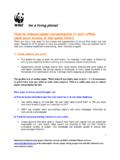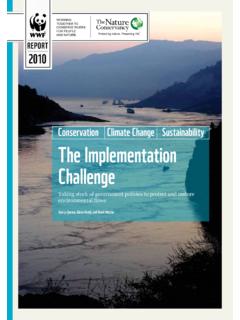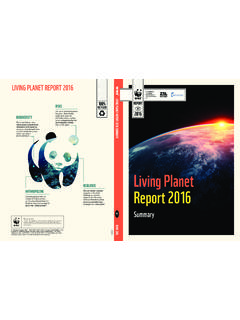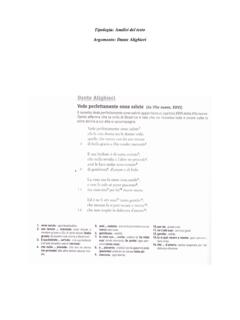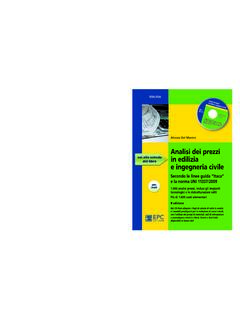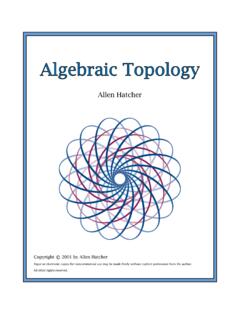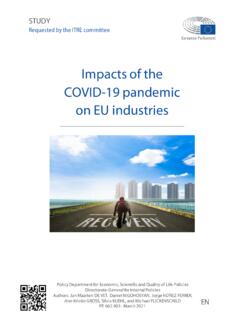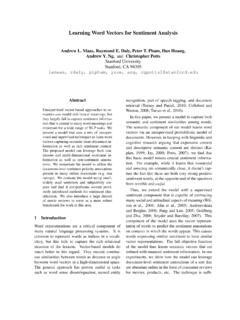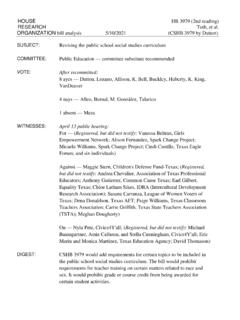Transcription of No pLAStIc IN NAture: ASSeSSINg pLAStIc INgeStIoN from ...
1 Analysis INT. 2019. No pLAStIc in Nature: ASSeSSINg pLAStIc INgeStIoN from nature to people AN ANALYSIS for WWF by Contents pLAStIc is polluting the air we breathe, the water we drink and the food we eat .. 6. Study methodology and 7. ACKNOWLEDGEMENTS. The analysis was written by Dalberg Advisors, Wijnand de Wit and Nathan Bigaud. WWF'S CALL FOR COLLECTIVE GLOBAL 12. DALBERG ADVISORS. 14. Dalberg Advisors is a strategy consulting firm that works to build a more inclusive and sustainable world where all people, everywhere, can reach their fullest potential. We partner with and serve communities, governments, and companies providing an innovative mix of services advisory, investment, research, analytics, and design to create impact at scale. WWF. WWF is one of the world's largest and most experienced independent conservation organizations, with over 5 million supporters and a global network active in more than 100 countries.
2 WWF's mission is to stop the degradation of the planet's natural environment and to build a future in which humans live in harmony with nature, by conserving the world's biological diversity, ensuring that the use of renewable natural resources is sustainable, and promoting the reduction of pollution and wasteful consumption. Published in June 2019 by WWF World Wide Fund For Nature (Formerly World Wildlife Fund), Gland, Switzerland. Any reproduction in full or in part must mention the title and credit the above-mentioned publisher as the copyright owner. Text 2019 WWF. All rights reserved Design: Ender Erg n ISBN 978-2-940529-95-7. Cover photo Mohammed Abdulraheem / Shutterstock / WWF. AN ANALYSIS for WWF by WWF International Dalberg The University of Newcastle Avenue du Mont-Blanc Rue de Chantepoulet 7 University Drive, Callaghan NSW. 1196 Gland, Switzerland 1201 Geneva, Switzerland 2308 Australia Alex Mustard / naturepl / WWF.
3 pLAStIc is A new study by the University of Newcastle, microplastics pollution has been shown to alter soil conditions, which can impact the Australia suggests that an average person could be health of fauna and increase the likelihood of harmful chemicals leaching into the soil13. ingesting approximately 5 grams of pLAStIc every week. polluting Microplastics are contaminating the air we breathe, the food we eat, and The equivalent of a credit card's worth of microplastics. the water we drink. Microplastics are defined as pLAStIc particles under 5mm in This summary report highlights the key ways pLAStIc gets size14. Primary microplastics are plastics directly released into the environment in the into our body, and what we can do about it. form of small particulates (shower gel microbeads, tyre abrasion, etc.) while secondary Increasing pLAStIc use and limited recycling microplastics are microplastics originating from the degradation of larger pLAStIc ( the air we breathe, results in towering pLAStIc production.)
4 Since degraded pLAStIc bags). 2000, the world has produced as much pLAStIc as all the the water we drink preceding years combined1, a third of which is leaked into nature2. The production of virgin pLAStIc has increased 200-fold since 1950 and has grown at a rate of 4 per cent An average person could be ingesting approximately 5 grams of pLAStIc per week. The equivalent of one credit card. and the food we eat. a year since 2000. If all predicted pLAStIc production capacity is reached, current production could increase by A new study by the University of Newcastle, Australia, takes a closer look 40 per cent by 20303. 5g at the data gap on what pLAStIc pollution means for human nutrition15. As of today, a third of pLAStIc waste ends up The study estimates the average amount of pLAStIc ingested by humans by analyzing in nature, accounting for 100 million metric and synthesizing the existing but limited literature on the topic.
5 The results confirm tons of pLAStIc waste in 20164. pLAStIc is used as concerns over the large quantity of pLAStIc we ingest every day. a disposable material, to such an extent that over 75% of all pLAStIc ever produced is waste5. A significant portion of this waste is mismanaged. Mismanaged waste is a direct Study methodology and limitations an average result of underdeveloped waste management infrastructure and refers to pLAStIc left uncollected, openly dumped, littered, or managed through uncontrolled landfills6. Of The study by the University of Newcastle, discussed below builds on a this mismanaged waste, about 87% is leaked into nature and becomes pLAStIc pollution7. For instance, if nothing changes, the ocean will contain 1 metric ton of pLAStIc for every person could be comprehensive review of existing studies to estimate pLAStIc INgeStIoN through inhalation, food, and beverages.
6 The approach was to focus on available data 3 metric tons of fish by 2025 8. IngestIng and to use conservative extrapolations and assumptions when data was not pLAStIc pollution affects the natural environment of most species on the planet. pLAStIc has been found at the bottom of the Mariana trench9 and in Arctic sea approxImately available. 5 grams of While this study represents a synthesis of the best available data, it builds on ice10, in addition to covering coastal ecosystems and accumulating in ocean gyres in all a limited set of evidence, and comes with limitations. The consensus among pLAStIc parts of the world. Animals get entangled in large pLAStIc debris, leading to acute and specialists is thus that while these numbers are in a realistic range, further chronic injury or death. Wildlife entanglement has been recorded in over 270 different studies are needed to get a precise estimate.
7 Species, including mammals, reptiles, birds and fish11. Animals also ingest large quantities of pLAStIc and are unable to pass the pLAStIc through their digestive systems, resulting every week A key limitation is the lack of data available on crucial metrics, such as weight in internal abrasions, digestive blockages, and death12. Further, toxins from ingested and size distribution of microplastics in natural environments, and the varying pLAStIc have also been shown to harm breeding and impair immune systems. Finally, quality of data collected. A widespread issue in data collection for instance is variations in sample collection methodologies leading to risks of contamination. This issue was for example raised by the scientific community regarding the Invisible plastics (2017). The Newcastle study team used assumptions Figure 1: Total production 6,000 and extrapolations to bridge data gaps and adjust for data quality.
8 It is of virgin pLAStIc by year, acknowledged that with every assumption and extrapolation, the level of 1950-2030 (forecasted). 5,500. 5,000. Half of the virgin pLAStIc uncertainty increases, and further research and data collection is needed to 4,500. produced between ascertain these results. 4,000 1950 and 2016 has 3,500 occurred since 2000. 3,000 The study reveals that consumption of common food and beverages may result in a weekly INgeStIoN of approximately 5 grams of pLAStIc , depending 2,500. PROJECTED on consumption habits. Out of a total of 52 studies that the University of Newcastle 2,000. 1,500 included within its calculations, 33 studies looked at pLAStIc consumption through food 1,000 and beverage. These studies highlighted a list of common food and beverages containing 500 microplastics, such as drinking water*, beer, shellfish, and salt.
9 The results are shown in 0 2000 2016 the figure 2. 1950 1960 1970 1980 1990 2000 2010 2020 2030. 6 No pLAStIc in Nature: ASSeSSINg pLAStIc INgeStIoN From Nature To People No pLAStIc in Nature: ASSeSSINg pLAStIc INgeStIoN From Nature To People 7. Figure 2: Estimated microplastics ingested through consumption of common foods and beverages (particles (0-1mm) per week). An average person potentially consumes as much as 1769. particles of pLAStIc every week just from water 1769 182 10 11. Drinking water* Shellfish Beer Salt * Drinking water includes both tap and bottled water Figure 3: Map of average percentage of tap water sample containing pLAStIc fibers and average number of fibers (>100um) per 500ml16. Percentage of tap water samples containing pLAStIc fibers Average number of fibers per 500 ml 98 %. %. %. Europe Lebanon US %. India Ecuador Uganda 4.
10 Indonesia % % %. Shane Gross / Shutterstock / WWF. 8 No pLAStIc in Nature: ASSeSSINg pLAStIc INgeStIoN From Nature To People No pLAStIc in Nature: ASSeSSINg pLAStIc INgeStIoN From Nature To People 9. The largest source of pLAStIc INgeStIoN is drinking water* with pLAStIc found in water (groundwater, surface water, tap water and bottled water) all over The long-term effects on our health of ingesting large quantities the world 17. All samples were found to contain pLAStIc in a study on bottled water, of pLAStIc are not clear but studies are underway. which used a limited sample of locations around the world18. As shown figure 3, a recent The specific effects of microplastics INgeStIoN on human health are not yet fully study, suggests large regional variations, with twice as much fibres per 500ml observed understood, but scientists suspect that the health hazard may be more important than is in American or Indian water as in European or Indonesian tap water 19.

